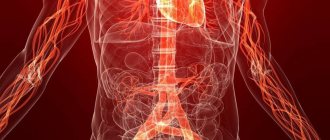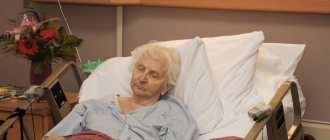In this article we will try to figure out whether it is possible to fly on an airplane after a stroke and what the consequences are.
No one is immune from diseases in this world; some of them can seriously threaten human life. For example, stroke has the second position on the list of deadly diseases. What kind of pathology is this and how is it dangerous for the patient?
A stroke is a circulatory disorder that causes cells in the brain to die, resulting in either death or varying degrees of disability.
Stroke: main causes
Is it possible to fly on an airplane after a stroke? We’ll figure it out below. In the meantime, let’s find out what causes the disease.
The main reason for this dangerous pathology is that one of the brain vessels is blocked by blood clots or foreign objects. Blood cannot get through this barrier; as a result, acute oxygen starvation occurs, and some of the cells die. This phenomenon is called “ischemic stroke”. It is better to find out in advance whether it is possible to fly after such a pathology.
A hemorrhagic stroke is when an artery ruptures and blood spills into the outer tissue of the brain, causing swelling that causes the death of cells and nerve fibers.
The main thing is timely help
This disease is very dangerous for human health; half of the cases are fatal. But if you provide the patient with medical care in time, his life can be saved. After a stroke has occurred, the patient must be placed in the intensive care unit within 3-4 hours, in some cases an operation by a neurosurgeon will be required. The less time it takes to get to the hospital, the higher the chances that the person will remain alive and will not become disabled. However, the area of the affected area of the brain is important: serious complications cannot be avoided if it is large.
Air transportation of a bedridden patient with a stroke
According to statistics, about six million people suffer from a stroke every year in the world. If a person is affected by such a serious disease as a stroke, any movement is difficult. At the same time, assistance and rehabilitation must be timely in order to maintain a person’s ability to work.
In what cases is it necessary to transport a patient after a stroke by plane?
There can be many reasons when it is necessary to transport a bedridden stroke patient by plane:
1. It is necessary to provide urgent medical care, and the nearest specialized hospital is far away.
2. The patient must be transported to another city or country for examination, since the nearest hospitals do not have the necessary equipment.
3. To complete a rehabilitation course, it is necessary to transport the patient over long distances.
4. To care for and monitor the patient’s condition, he is taken to relatives living in another city or country.
Air transportation of patients with stroke allows you to quickly deliver the patient to the destination and, unlike road transportation, the patient does not experience discomfort from bad roads during transportation.
What should you do when transporting a patient with a stroke by air?
When thinking about air transportation of a bedridden patient with a stroke, you need to find a competent doctor who will accompany the patient during the flight and must:
1. Consider the nature of the stroke (hemorrhagic or ischemic stroke) and the severity of the patient’s condition. Possibility of air transportation of a patient with a stroke at the time of the required flight.
2. Prepare all the necessary medications, resolve the issue of oxygen support during the air travel of a stroke patient, depending on the blood oxygen saturation readings, prepare and set up the operation of the medical equipment necessary to assess the stability of the condition during the entire air travel of the stroke patient.
3. Resolve all organizational issues with the airline: submit an application to the airline for the installation of special stretchers for air transportation of bedridden patients; prepare all the necessary medical documents so that the airline does not refuse air transportation for this patient.
4. Fill out an application at the airport of departure and arrival for a special vehicle with a lifting cabin (ambulift), which boards bedridden or inactive people. Depending on the patient’s condition, this application is processed through the airport medical center or the escort service for disabled people and people with limited mobility.
To transport a patient with a stroke, a special recumbent seat is used, equipped with seat belts, which must be fastened during takeoff and landing to secure the patient. To avoid complications during the flight, it is advisable that the patient be accompanied by a doctor.
Also of great importance when transporting such patients is passing customs control, because they are not able to stand in line or go through detectors.
Fortunately, today there are companies that can take on the solution to all these problems. For example, on our website aviamedicina.ru, you can leave a request, and within 3-5 days the issue of transporting the patient by plane will be resolved.
Long rehabilitation
Even with a successful operation, the patient will undergo rehabilitation for a long time. Most people after a stroke learn to live again and deal with the negative consequences of the disease. On average, a patient’s normal life can begin only after 2 months. It takes much longer to return to work; Driving a car or business trips to other cities and countries are unavailable to many for a very long time.
Patients who have suffered a stroke in the recent past, whose life was completely or partially associated with travel, ask doctors the question: “Is it possible to fly on an airplane after a stroke?”
When can you fly after a heart attack?
The answer to this question directly depends on the rehabilitation period that the doctor has determined for you. If you followed all the recommendations and successfully completed the course, then in the absence of complications and other circumstances, you will be allowed to fly. The recovery period depends on the type of illness suffered, the extent of the affected area, the causes of the pathology, stenting operations undergone, etc. To give an approximate idea of how long it takes to fly, below are approximate rehabilitation periods for some cases:
- Small focal myocardial infarction – 2 weeks.
- Large focal myocardial infarction – 6 months.
- Stroke – at least 2 months, on average – 6 months under favorable circumstances.
- Vascular stenting surgery – 2 weeks.
Important! The data provided is for informational purposes only. Your doctor will tell you the exact timing.
Even after rehabilitation, there is no need to rush to fly by plane unless absolutely necessary. The more time has passed since the illness, the better. Remember that it is your life, not just your health, that is at stake. Cardiovascular diseases are very insidious, a relapse can occur at any time, and without qualified help a person’s life cannot be saved.
Will flights be allowed?
As a rule, the doctor's answer will be positive. You can use air transport, but there are certain conditions and restrictions. This is important to remember. The problem is that, in fact, flying is a tiring and difficult process even for a healthy person.
Due to severe changes in pressure, stress and panic, and an unfavorable atmosphere in the aircraft cabin, repeated cerebral hemorrhage may occur, which will be fatal for most patients. What is especially scary is that qualified assistance will not be provided, because it is impossible to do this at altitude.
What points should be taken into account?
So, what is the opinion of doctors about whether it is possible to fly after a stroke? Typically, attending physicians allow such travel if the following points are taken into account:
- How much time has passed. If more than six months have passed since the operation, but not less than 2 months. It is a big plus if no health-threatening complications arise during this period. That is, after complete recovery from a stroke, you can fly.
- Quality of rehabilitation. The recovery period for the patient was completed successfully, massage and physical exercises were used.
- At what level is your blood pressure? It should be normal, without a sharp rise and fall, the threshold of 140/90 should not be exceeded. Regular intake of prescribed medications is important.
- Is the patient susceptible to aerophobia? Is it possible to fly after a brain stroke if you have a fear of flying? It is extremely important that a person does not suffer from aerophobia, as it provokes severe anxiety and stress.
If all conditions are met and the patient has confidence in his abilities, then he is allowed to fly and is prescribed certain recommendations.
What determines permission to fly after a heart attack or stroke?
Having suffered a myocardial infarction or stroke is not a death sentence or a reason to give up air travel forever. But before planning a flight, you should definitely consult your doctor and get his permission. You will receive such permission if:
- Enough time has passed since the illness (the doctor will determine this period himself, since only he knows your anamnesis and medical history). It is not recommended to board a plane before 2 months. On average, doctors give permission to fly on an airplane after 6 months.
- The rehabilitation was successful: you strictly followed the doctors’ recommendations, completed a course of massage, physical therapy, and other physiotherapeutic procedures, and are currently healthy.
- Your blood pressure is stable. The highest indicator should not exceed 140/90. You do not experience surges and there are no complications (hypertension is a complication that occurs in 90% of cases after cardiovascular diseases).
- You are not stressed and are not afraid to fly. One of the negative factors that provoke complications and increase the risk of relapse is fear of flying, which causes pressure surges due to fear and panic. If you do not have aerophobia, you will be allowed to fly.
- You have been examined. Before a flight after a heart attack or stroke, it is necessary to undergo an ECG or ultrasound of the cerebral vessels to exclude the possibility of manifestations of the consequences of an aneurysm.
- You have been trained to take preventive medications. It is advisable to take a course of blood pressure stabilizing, sedative and blood thinning medications.
- You have your own first aid kit with medications recommended by your doctor, and you clearly know what to take and when.
Important! It will be a big plus if no serious complications have arisen during the entire period after the illness.
Compliance with all these conditions is the key to your safety and a smooth flight without complications. It is important to understand that heart attack and stroke are pathologies that, in case of recurrence, require immediate qualified assistance, which is not available on board the aircraft. Therefore, in order to minimize risks, you need to carefully prepare in advance and take care of your safety.
Important! If emergency transportation of a person with a stroke or heart attack is required, transportation is carried out accompanied by a team of qualified doctors who are provided with all the necessary equipment and medications.
The preparation must be correct
We continue to figure out whether it is possible to fly after a stroke. In advance, the patient must prepare himself and his blood vessels for high load.
The preparation process includes:
- Taking certain medications. Most often, doctors prescribe special blood-thinning medications (aspirin is considered the most popular) that prevent blood clots in blood vessels and relapse of the pathology.
- Passing examinations. Before the flight, an electrocardiogram and ultrasound examination of the vessels of the head are required. This is required to eliminate the possibility of aneurysm formation. During the flight, pressure changes are possible, and an aneurysm may rupture, leading to a fatal brain hemorrhage on an airplane after a stroke.
- Own first aid kit. The patient must plan in advance what medications he will take with him on the plane. The first aid kit should consist of medications that stabilize blood pressure and sedatives; medications against motion sickness are also useful.
If the preparation is carried out correctly by the patient, then it is possible to fly after a stroke.
Also, the trip will be comfortable if you purchase special pillows for the head, in this way the unnecessary load on the cervical spine and blood vessels will be reduced. Excessively fatty foods are contraindicated before a flight; it is better to prefer light foods.
Symptoms worsen at altitude
At altitude, the typical symptoms of hypertension worsen:
- The occurrence of migraine is a cerebrovascular disease due to prolonged spasm of blood vessels in the head. A dangerous complication is the cerebral form of hypertension (stroke). To prevent arterial hypertension from developing into a malignant form, it is worth defeating migraine at the initial stage.
- The appearance of pressing chest pain. The heart works overtime, so discomfort in the chest may turn out to be angina. If there is a history of myocardial ischemia in hypertensive patients, they should fly with great caution.
- Having severe shortness of breath. Limited space and elevation lead to a feeling of lack of oxygen; reflex shortness of breath may occur in response to stress. To avoid real suffocation, the patient’s breathing must be deep and even; oxygen cocktails can come to the rescue.
- Development of tachycardia. The intense work of blood vessels leads to a rapid heartbeat, because they quickly pump large amounts of blood. This leads to spasm of blood vessels and tension in their walls.
Threats encountered during flight
Traveling by plane also has a negative impact on a healthy body, and for a person who has suffered an acute cerebrovascular accident, it increases. Heart diseases (for example, arrhythmia) are factors in the occurrence of stroke, since disturbances in the rhythm of heart contractions lead to thrombus formation.
During flight conditions, the load on the cardiovascular system increases due to many health hazards:
- thin dry air;
- low cabin pressure;
- restriction of physical activity;
- vibration;
- stress due to fear of flying.
Therefore, it is necessary to minimize their exposure.
Lack of oxygen
During a stroke, neurons in the affected part of the brain die. The surrounding cells suffer from irreversible changes leading to necrosis. To prevent this, sufficient oxygen levels are necessary.
At altitude, the air in the aircraft cabin is thin, which increases the possibility of hypoxia. Neurons located close to the pathological focus may die due to lack of oxygen during the flight.
Low blood pressure
During flight, the cabin pressure is maintained at 75% of normal atmospheric pressure. This leads to a decrease in oxygen concentration in the blood; the risk of hypoxia increases.
This effect on the body is compensated by increasing the heart rate and constricting blood vessels, which leads to increased blood pressure and, in turn, increases the risk of stroke. Some airlines have special oxygen bags or inhalers on board to provide timely treatment for hypertension.
Vestibular disorders
When traveling by plane, kinetosis motion sickness may occur. This is the reaction of the vestibular apparatus to the oscillatory movements of the aircraft. Manifested by dizziness, nausea, vomiting. In the post-stroke state, this is a dangerous additional load on the blood vessels of the brain, which can lead to another apoplexy.
Physical inactivity
Forced prolonged sitting in one position leads to an increase in blood viscosity and increases the risk of thrombosis of the veins of the lower extremities and blockage of blood vessels in the brain.
Dry air
On board an aircraft, the air becomes dry as it passes through the cleaning system. As a result, the mucous membranes of the upper respiratory tract work harder to deliver oxygen from the air to the alveoli of the lungs, and after a while they dry out. For this reason, after a long flight, the oxygen content in the blood drops. Also, in conditions of low humidity, general fatigue of the body is observed.
Maneuvers and vibration
During takeoff, landing, climb and descent, or when an aircraft enters a turbulence zone, a blood clot can break off and enter the brain vessel through the bloodstream, which can lead to the development of a cerebral infarction (ischemic stroke).
Fear
Fear of flying, or aerophobia, is a risk factor for a person who has had a stroke due to the stress and anxiety associated with having to fly. In this case, a rapid heartbeat, shortness of breath, and increased blood pressure appear, which is fraught with the development of a hypertensive crisis and repeated stroke.
What are the dangers of flying after a stroke?
However, during the flight, the patient may in any case encounter various kinds of problems that cannot be foreseen in advance.
So, the problems could be the following:
- Dry air. The skin dries quickly due to air conditioning on airplanes, and the unpleasant thing is that the body quickly becomes dehydrated. But this provokes thickening of blood in the vessels, which can turn into a mortal danger for a person after a stroke.
Therefore, you need to drink more fluids, but not tea and coffee, but pure water, and still. Alcoholic drinks are strictly prohibited; their influence is detrimental to the cardiovascular system, and as a result, a heart attack can occur.
Stay active and keep in touch with friends and acquaintances
Many people feel weak, have difficulty speaking, or have any other problems after a stroke. This leads to them losing interest in the outside world and not wanting to communicate with friends and acquaintances. An important step in rehabilitation after a stroke is socialization. You may find it difficult to go to places you used to go to before your stroke because of your mobility problems, or you may be worried that you will not be able to cope with your problems outside the home. You may find it easier to stay home, but this can lead to isolation, loneliness and low mood. There is always a solution to problems, you can take the help of others or use a stroller to move around. Try to keep in touch with your close friends, invite them to visit or travel with them. It will help if your friends know your capabilities, what you can and cannot do. Meeting new people may be intimidating at first, but it is likely that meeting new people can be especially beneficial for you. Often people make new friends with people who have also had a stroke, and this helps them share their experiences. A positive mood, an active life and maintaining relationships with friends and acquaintances are the key to your recovery.
Long sitting position
Passengers on the plane remain motionless for a long time. Physical inactivity can cause blood clots, resulting in a recurrent stroke. This possibility will be higher the longer the flight lasts. Flights typically last more than five hours, so passengers often experience swollen feet.
Wearing compression garments under regular clothing will help prevent this. Women can buy special compression tights. They will disperse the blood where it stagnates. Sometimes it is acceptable to get up from your seat at least once and walk around the salon, of course, when this is not prohibited. To disperse blood throughout the body, it is good to rotate your hands, feet and neck. In general, simple health-improving exercises will help.
Turbulence
An unpleasant vibration appears when the plane hits air pockets. Under its influence, the heart rhythm may be disrupted, as well as blood circulation and blood supply to the brain. A new blood clot forms, and subsequently another stroke.
The only advice in this case would be the following. You need to calm down and try to sleep. If you follow all the doctors' recommendations, nothing bad should happen, especially if throughout the flight the patient kept his blood pressure under control, consumed enough fluids and stretched his legs. The trip will be comfortable and without serious consequences. How to fly by plane after a stroke?











